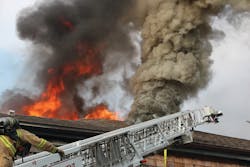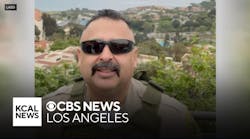SPOKANE FIRE DEPARTMENT
Chief: Bobby Williams
Personnel: 300 career firefighters
Stations: 15
Apparatus: 12 pumpers, 3 aerials, 2 quints, 1 heavy rescue, 2 battalion chief units, 11 ALS units, 7 BLS units, 4 reserve engines, 2 reserve ladders
Population: 212,000
Area: 69 square miles
On Tuesday, Sept. 25, 2012, a four-alarm fire nearly destroyed a 12-unit apartment complex in the South Hill section of Spokane, WA. Late discovery of the fire and a lack of personnel on the initial alarm for the rapidly spreading fire required additional alarms. Congested, narrow streets blocked access for initial companies.
Nearly 100 firefighters responded with 13 engines, two quints, four ladders and one heavy rescue along with seven chief officers. Aggressive and coordinated truck and engine company work were required to contain the fire.
The two-story, 160-by-50-foot, Type V mixed construction apartment building was erected in 1969. While the building was only two stories with a subterranean garage, it was built into a hill, which added to the extreme terrain firefighters had to contend with, essentially making it a three-story complex. The building had a pitched wood-frame roof made of plywood and asphalt shingles. The building contained 13,000 square feet of space. There were no fire protection or detection systems in the building.
The building is in an extremely densely populated area with mixed residential structures, high-rise apartments and medical buildings. Spokane’s South Hill is a historically high-value, older section of the city with extremely narrow roads and boulevards inter mixed with wildland fuel.
Initial response
Spokane Fire Department Engine 9 and was dispatched at 4:03 P.M. with a crew of three for a smoke investigation in the area of Deaconess Hospital in the South Battalion. Engine 9 arrived in the neighborhood and observed smoke, but initially could not locate the source due to the high density and limited access of the area. Numerous civilians were also walking in the streets looking for the source of the smoke and contributing to the access challenges.
While Engine 9 was maneuvering through 7th Avenue, a civilian flagged down the company and advised them of the location of the fire. Engine 9 arrived in the area near 7th and Lincoln and immediately requested a full-alarm assignment at 4:06 P.M. for a working apartment building fire. Firefighters found heavy fire on the third floor, Alpha side, west corner of the building.
Responding were Engines 1 and 6; PL (Pumper/Ladder) 11, a quint with a 75-foot aerial ladder; Ladder 4, a 100-foot tillered ladder; Heavy Rescue; Battalion Chief Craig Cornelius of the South Battalion; and Battalion Chief Clive Jones of the North Battalion responded.
Upon arrival, Cornelius immediately requested a second alarm. Engines 7 and 16; Ladder 1, a 110-foot truck company; and Ladder 2, an 85-foot aerial platform, responded at 4:12 P.M. Access and apparatus placement were extremely important due to the hilly terrain and congested streets. Engine 9 and Ladder 4 were positioned on the Alpha side with all other companies positioned on the Bravo side or staged north of the incident at 7th and Lincoln.
Engine 9 was supplied with a 400-foot, five-inch line laid by Engine 1. Engine 9 supplied multiple 1¾-inch attack lines, 2½-inch attack lines and hotel packs to companies operating on the first and third floors. Engine 9 also supplied Ladder 4’s water pipe as a contingency measure. All other initial-alarm engine companies were assigned to support the fire attack and search operations on the third floor.
Roof operations
The crews from Ladders 2 and 4 accessed the roof from both aerial devices to place offensive cuts in the pitched roof near the main body of the fire and multiple defensive trench cuts on both sides of adjacent sections of the building. Remaining firefighters from both ladder companies placed ground ladders for a second means of egress.
Firefighters then went to the third floor to force entry into the apartments, conduct searches and open up ceilings in coordination with the roof companies. The attic structure was a shared common open space. The connected attic let the fire grow quickly, unimpeded throughout the entire roof system.
Spokane Fire Department Assistant Chief Brian Schaeffer assumed the position of incident commander upon arrival. The incident was upgraded to a third alarm at 4:27 P.M., bringing Engines 2, 3 and 4 to the scene.
As the incident continued to grow in complexity, the incident management organization expanded. The larger organization included Spokane command staff personnel Fire Chief Bobby Williams as public information officer (PIO), Deputy Fire Chief David Leavenworth as incident safety officer and Darrell Ruby from the Office of Emergency Management as liaison officer. The general staff positions utilized included Cornelius as operations section chief with division/group supervisors assigned to Division 1, Division 2, Division 3, rapid intervention team group and exposure group, Spokane Division Chief Art Nichols as logistics section chief and Spokane Valley Chief Andy Hail as planning chief.
Schaeffer requested a fourth alarm at 4:40 P.M. Engine 18, Quint 13 (with a 75-foot aerial ladder), Spokane Fire District Ladder 91 and Spokane Valley Engine 6 and additional command staff responded.
Spokane’s historic lower South Hill is a dense urban environment with multiple exposures, including multi-family homes, mansions, heavy-fuel pine trees and other buildings in close proximity on all sides of the structure.
A formal firefighter rehab area was established west of the incident. It was staffed with the Spokane Fire Department’s physician and training staff to accommodate medical surveillance for all personnel on the fireground. This is mandatory for all personnel after using two self-contained breathing apparatus (SCBA) bottles or on request of any member and includes a formalized exam with vital signs, carbon monoxide levels and temperature.
Under control
Schaeffer declared the fire under control at 6:10 P.M. Mutual aid units began being released at 6:13 P.M. The last initial-arriving Spokane units left the scene at 7:47 P.M. and off-duty callback companies remained on scene overnight as a dedicated fire watch company. Weather conditions at the time of the fire were clear with a temperature of 74 degrees. There were no firefighter or civilian injuries.
The Spokane Fire Department’s Special Investigation Unit (SIU) conducted an origin-and-cause investigation into the fire. The fire was determined to have originated in the attic space at the west end of the structure. An ignition source was not determined due to the heavy fire damage and consumption of the structural members of the entire west end roof and walls. The SIU was unable to locate an exact point of origin and due to the heavy fire damage to the structure and extreme scene alteration, the cause of the fire is undetermined. Damage was estimated at more than $3.2 million.
LESSONS LEARNED
PROBLEMS
• Late discovery of the fire and lack of personnel on the initial alarm for the rapidly spreading horizontal fire required additional alarms.
• Congested, narrow streets obstructed initial ladder companies and engines from reaching areas of the building effectively. The incident commander had the police department order the removal of nearly 20 parked vehicles by towing companies to a nearby supermarket parking lot. This alleviated the access problems, but it was the first time Spokane Fire Department had ever done it.
• The extreme sloped hillside (South Hill) made it very difficult for outriggers on ladders, ground ladder placement and overall exertion for personnel to walk from their apparatus in staging to the fire.
• A self-contained breathing apparatus (SCBA) failure during the initial phases of the incident created a separate incident of itself. Based on Department procedure, the personnel involved were immediately questioned and equipment quarantined. In this case, the member was uninjured and an investigation was completed by the department’s Special Investigation Unit (SIU) and safety officer.
SUCCESSES
• The use of wrecker services through city contracts to forcibly move vehicles to a nearby supermarket parking lot where owners were advised through the public information officer (PIO) to retrieve them. As a result of this incident, the department has solidified a procedure with law enforcement to remove vehicles impeding fire department operations.
• The fire department routinely drills with high-rise situations, including specific attention to air management, stairwell-based fire attack, the Incident Command System (ICS) and aggressive vertical ventilation. Often for incidents of this complexity, the department reinforces its incident command structure and formalizes the command staff.






